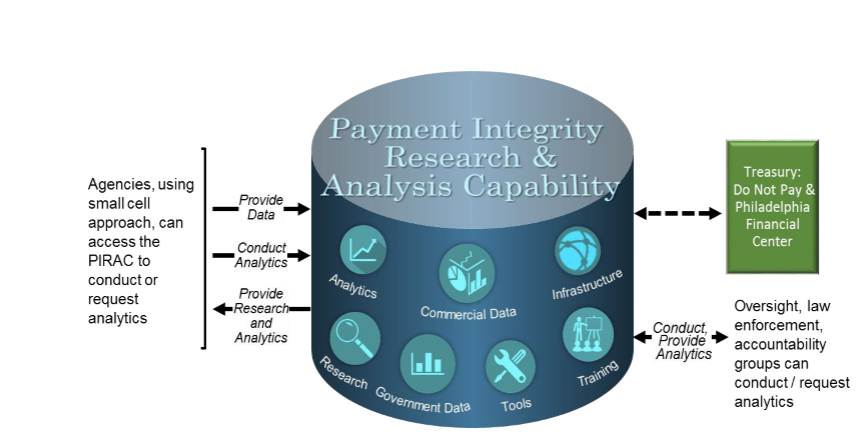
Improper payments continue to plague the federal government, though many actions are in motion to help turn the tide. The Trump Administration’s Building a Better America: A Plan for Fiscal Responsibility, released in July 2017, emphasizes reducing improper payments, currently estimated by the Government Accountability Office (GAO) to total $144.3 billion in 2016, up from $107.1 billion in 2012.
The plan further stipulates that Congress should establish an independent commission to find “tangible ways to reduce government-wide improper payments by 50 percent within the next five years.” The Office of Management and Budget (OMB) provides some additional guidance on where to focus attention (refer to the high-priority programs and Government-Wide Improper Payment Root Causes (FY2016) to name a few), Ultimately, though federal agencies will collaborate with OMB to craft future Strategic Plans and IT Modernization strategies, they will identify their course of action and implement their own solutions.
International Fraud Awareness Week gives us a chance to examine the improper payments problem, while acknowledging the considerable efforts already in place by the OMB and across federal agencies working hard to be good stewards with taxpayer dollars.
Improper payments can manifest in countless ways. For example, one area that doesn’t get much attention is beneficiary travel voucher fraud.
Travel voucher fraud afflicts agencies across government, and takes many forms. While the magnitude of loss from government travel voucher fraud is difficult to accurately measure, it can range from minor losses from simple schemes to much more sophisticated schemes that net large sums of money. For instance, it could be as simple as government employees padding mileage for larger reimbursements. Something like that doesn’t break the bank, but other schemes may involve collusion that facilitates massive losses. For example, 28 Marine reservists were charged with fraud for a complex scheme involving fake hotel receipts and false addresses that exceeded reasonable commuting distances, thus qualifying for more costly reimbursements.
New approaches to cracking down on improper payments
In the sophisticated scheme above, supporting documentation was falsified. However, it’s often the lack of supporting documentation that makes it so difficult to differentiate improper payments from legitimate ones, per the GAO.
While improper payments estimates are not a measure of fraud, a lack of sufficient supporting documentation may mask the true causes of improper payments—including fraud. When payments lack the appropriate supporting documentation, their validity cannot be determined. It is possible that these payments were for valid purposes, but it is also possible that the lack of documentation could conceal fraudulent activities. (GAO-17-631T, Report and testimony before the Committee on the Budget, U.S. Senate, May 2017)
The MITRE Corporation, a not-for-profit company operating multiple federally-funded research and development centers, has done considerable work to study and recommend ways to prevent and detect improper payments. In their 2016 technical report on payment integrity1 MITRE recommends the government:
Establish a shared, government-wide research and data analytics capability – a Payment Integrity Research and Analysis Capability (PIRAC) – to enhance prevention and detection of improper payments (Figure ES-2). An important feature of the PIRAC would be evaluating alternatives for predictive and prescriptive modeling of future trends and their potential impacts on Payment Integrity to serve as an “early warning system” to help inform planning and prevention activities.

Similar language encouraging shared, government-wide research and data analytics capability can be found in the proposed Federal IT Modernization Executive Summary’s language that calls for a “shift toward a consolidated IT model by adopting centralized offerings for commodity IT.”
Will future Information Technology Strategic Plans and Enterprise Design objectives echo the GAO and Administration’s recommended methods for reducing improper payments “50 percent within the next five years?” Might these include a “shared, government-wide research and data analytics capability” that helps to leverage trusted supporting documentation and enable analytical approaches to render more accurate fraud detection results?
When a government employee adds an extra zero to their mileage report, will the system catch it?
With innovative ideas like MITRE’s Payment Integrity Research and Analysis Capability, and the Administrations leadership, government’s ability to leverage analytics and narrow the improper payment gap will likely be realized sooner rather than later.
1MITRE Technical Report, Document Number MTR160040. (2016). GOVERNMENT-WIDE PAYMENT INTEGRITY: NEW APPROACHES AND SOLUTIONS NEEDED, https://www.mitre.org/sites/default/files/publications/pr_16-0123-government-wide-payment-integrity.pdf
